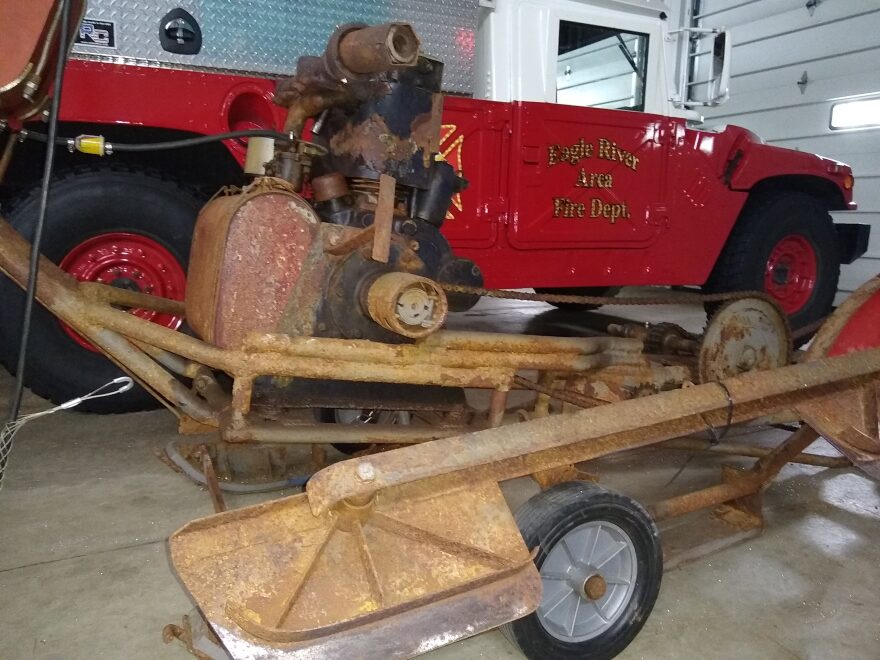Michael Anderson uses a long bit on a drill to bust through the ice on Silver Lake in Eagle River.
“That would be a good depth for an ice castle right now,” Anderson says, measuring about 15 inches of ice.

That’s plenty for harvesting and forming into blocks for ice-castle building.
But there’s a problem. A deep layer of slush on Silver Lake makes it inaccessible to the machines and trucks needed to transport ice blocks.
Without the ice blocks, there’s no ice castle downtown, and that means Anderson has to break the bad news to a lot of people.
“You walk around town and people would be asking you, the big question was, ‘Is there going to be an ice castle? When is there going to be an ice castle? What can we do to make this ice castle happen?’ Everyone just enjoys it,” he says.
It’s the second consecutive winter without the castle, a magnificent, brightly-lit structure usually rising above downtown. Anderson is the Eagle River Fire Chief and in charge of the castle. But, due to uncooperative weather, the castle has been built just twice since 2014.

That fits into a long-term trend detailed by a new study, which says issues with ice touch culture, business, and even religion in northern latitudes across the world.
It didn’t use to be this way.
When Anderson was a kid, he watched as his dad, who’s also a firefighter, harvested ice and built the castle.
“I don’t know how much help I was, but I was out there to experience the hard work that the guys were doing at the time and the joviality and the fun that goes along with doing a good, hard project,” he says.
Volunteers in Eagle River have been building the castle since the 1930s, and they’re still using one of the original tools for harvesting ice.

“In order to start it, it has a hand crank. It’s definitely before OSHA rules,” Anderson says with a laugh.
But ice thick enough for harvesting is just one part of the puzzle. The ice has to be relatively free of slush to allow it to be taken off the lake.
“It’s all about being able to get vehicles onto the ice at the boat landing in order to be loaded with 20 blocks of ice,” Anderson says. “Each block weighs about 60 or 70 pounds.”
This year, highly variable winter weather made access impossible.
That struggle for good conditions sounds familiar to Lesley Knoll.
“We have really long winters. They’re cold. Ice has become a really important part of what a lot of people do to get by in those winters, for recreation or social uses,” she says.

Knoll is the station biologist at the University of Minnesota’s Itasca Biological Station near Bemidji. She’s the lead author of a study examining cultural effects of ice loss on communities. Ice loss could have a negative effect on up to 230,000 lakes worldwide.
“This is a really unexplored area,” Knoll says. “There have been some studies looking at this topics, but way less than what you find when you consider the summertime.”
Knoll’s study brings in examples of ice-related religious ceremonies in Japan, Germany, and Switzerland; outdoor ice skating races in Sweden; and ice fishing tournaments in the United States.
People are seeing a decline in ice cover, she says, but generally aren’t associating it with its true cause.
“People are noticing that, but then taking that next step to climate change, I don’t hear that so much,” Knoll says. “I think this study can really help highlight the changes that are happening to lakes, to ice cover from climate change that affect people.”
Knoll points out, in the north, ice often provides a sense of place and a sense of identity we risk losing.
In Wisconsin this winter, poor ice conditions have already forced cancellation or modification of the Frozen Tozen ice fishing tournament in Boulder Junction, the Hodag Lions Fisheree in Rhinelander, the Loop Around the Lake snowshoe and ski race in Minocqua, and the Bike Across Bago on Lake Winnebago.

For the builders of the Eagle River Ice Castle, “wait until next year” has gotten more and more routine. But Michael Anderson has learned not to be disappointed when no castle goes up.
“For every year we don’t do it, it makes the years we can that much more enjoyable,” he says.








